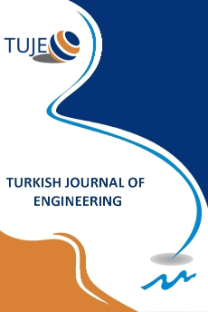GRAPHENE PRODUCED WITH USING SURFACTANT FROM EXPANDED GRAPHITE
GRAPHENE PRODUCED WITH USING SURFACTANT FROM EXPANDED GRAPHITE
___
- Arao, Y., Mori, F., & Kubouchi, M. (2017). “Efficient solvent systems for improving production of few-layer graphene in liquid phase exfoliation.” Carbon, Vol. 118, pp. 18-24.
- Dhakate, S. R., Chauhan, N., Sharma, S., Tawale, J., Singh, S., Sahare, P. D., & Mathur, R. B. (2011). An approach to produce single and double layer graphene from re-exfoliation of expanded graphite. Carbon, 49(6), 1946-1954.
- Durge, R., Kshirsagar, R. V., & Tambe, P. (2014). “Effect of sonication energy on the yield of graphene nanosheets by liquid-phase exfoliation of graphite.”Procedia Engineering, Vol. 97, pp. 1457-1465.
- Huo, C., Yan, Z., Song, X., & Zeng, H. (2015). “2D materials via liquid exfoliation: a review on fabrication and applications.” Science Bulletin, Vol. 60, pp. 1994- 2008.
- Lee, X. J., Hiew, B. Y. Z., Lai, K. C., Lee, L. Y., Gan, S., Thangalazhy-Gopakumar, S., & Rigby, S. (2019). “Review on graphene and its derivatives: Synthesis methods and potential industrial implementation.”Journal of the Taiwan Institute of Chemical Engineers, Vol. 98, pp. 163-180.
- Monajjemi, M. (2017). “Liquid-phase exfoliation (LPE) of graphite towards graphene: An ab initio study.” Journal of Molecular Liquids, Vol. 230, pp. 461- 472. Narayan, R., & Kim, S. O. (2015). Surfactant mediated liquid phase exfoliation of graphene. Nano Convergence, 2(1), 20.
- Novoselov, K. S., Geim, A. K., Morozov, S. V., Jiang, D., Zhang, Y., Dubonos, S. V., ... & Firsov, A. A. (2004). Electric field effect in atomically thin carbon films. science, 306(5696), 666-669.
- Wei, Y., & Sun, Z. (2015). “Liquid-phase exfoliation of graphite for mass production of pristine few-layer graphene.” Current opinion in colloid & interface science, Vol. 20, pp. 311-321.
- Xu, J., Dang, D. K., Liu, X., Chung, J. S., Hur, S. H., Choi, W. M., ... & Kohl, P. A. (2014). “Liquid-phase exfoliation of graphene in organic solvents with addition of naphthalene.” Journal of colloid and interface science, Vol. 418, 37-42.
- Zhu, L., Zhao, X., Li, Y., Yu, X., Li, C., & Zhang, Q. (2013). “High-quality production of graphene by liquid phase exfoliation of expanded graphite.” Materials Chemistry and Physics, Vol. 137, pp. 984-990.
- ISSN: 2587-1366
- Yayın Aralığı: 4
- Başlangıç: 2017
- Yayıncı: Mersin Uüniversitesi
WIND POWER PLANT LAYOUT OPTIMIZATION USING PARTICLE SWARM OPTIMIZATION
Mustafa ŞEKKELİ, Ceyhun YILDIZ, İbrahim Çelik
Ali SÖNMEZ, Ömer GÜLER, Öyküm BAŞGÖZ, Seval Hale GÜLER
CLASSIFICATION OF UAV POINT CLOUDS BY RANDOM FOREST MACHINE LEARNING ALGORITHM
REMOVAL OF COD AND SURFACTANTS FROM GREY WATER BY FENTON TYPE PROCESSES
Serkan ŞAHİNKAYA, Gamze ÖZGÜROĞLU
GRAPHENE PRODUCED WITH USING SURFACTANT FROM EXPANDED GRAPHITE
Ali SÖNMEZ, Seval Hale GÜLER, Öyküm BAŞGÖZ, Ömer GÜLER
Serkan ŞAHİNKAYA, Gamze ÖZGÜROĞLU
